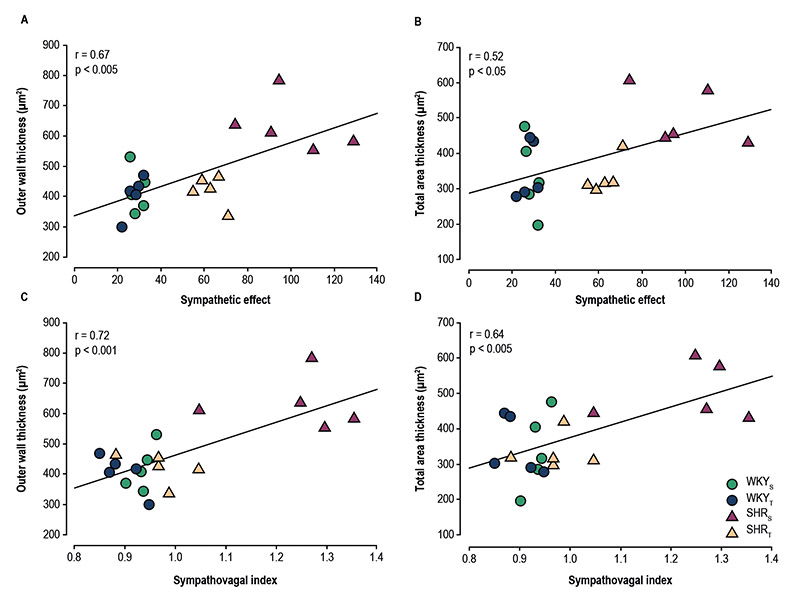Volume 110, Nº 3, March 2018
DOI: http://www.dx.doi.org/10.5935/abc.20180053
ARTIGO ORIGINAL
Exercise Training Attenuates Sympathetic Activity and Improves Morphometry of Splenic Arterioles in Spontaneously Hipertensive Rats
Marina de Paiva Lemos
Gustavo Ribeiro da Mota
Moacir Marocolo
Carla Cristina de Sordi
Rosângela Soares Chriguer
Octávio Barbosa Neto

Figure 3 – Correlation coefficient between sympathetic effect and outer wall thickness (A), sympathetic effect and total area thickness (B), sympathovagal index and outer wall thickness (C), sympathovagal index and total area thickness (D).
Abstract
Background: Alterations in the structure of resistance vessels contribute to elevated systemic vascular resistance in hypertension and are linked to sympathetic hyperactivity and related lesions in target organs.
Objective: To assess the effects of exercise training on hemodynamic and autonomic parameters, as well as splenic arteriolar damages in male Wistar Kyoto (WKY) and Spontaneously Hypertensive Rats (SHR).
Methods: Normotensive sedentary (WKYS) and trained (WKYT) rats, and hypertensive sedentary (SHRS) and trained (SHRT) rats were included in this study. After 9 weeks of experimental protocol (swimming training or sedentary control), arterial pressure (AP) and heart rate (HR) were recorded in freely moving rats. We assessed the autonomic control of the heart by sympathetic and vagal autonomic blockade. Morphometric analyses of arterioles were performed in spleen tissues. The statistical significance level was set at p < 0.05.
Results: Resting bradycardia was observed in both trained groups (WKYT: 328.0 ± 7.3 bpm; SHRT: 337.0 ± 5.2 bpm) compared with their respective sedentary groups (WKYS: 353.2 ± 8.5 bpm; SHRS: 412.1 ± 10.4 bpm; p < 0.001). Exercise training attenuated mean AP only in SHRT (125.9 ± 6.2 mmHg) vs. SHRS (182.5 ± 4.2 mmHg, p < 0.001). The WKYT showed a higher vagal effect (ΔHR: 79.0 ± 2.3 bpm) compared with WKYS (ΔHR: 67.4 ± 1.7 bpm; p < 0.05). Chronic exercise decreased sympathetic effects on SHRT (ΔHR: -62.8 ± 2.8 bpm) in comparison with SHRS (ΔHR: -99.8 ± 9.2 bpm; p = 0.005). The wall thickness of splenic arterioles in SHR was reduced by training (332.1 ± 16.0 μm2 in SHRT vs. 502.7 ± 36.3 μm2 in SHRS; p < 0.05).
Conclusions: Exercise training attenuates sympathetic activity and AP in SHR, which may be contributing to the morphological improvement of the splenic arterioles. (Arq Bras Cardiol. 2018; 110(3):263-269)
Keywords: Exercise; Physical Exertion; Hypertension; Vascular Resistance; Arterioles; Rats.















